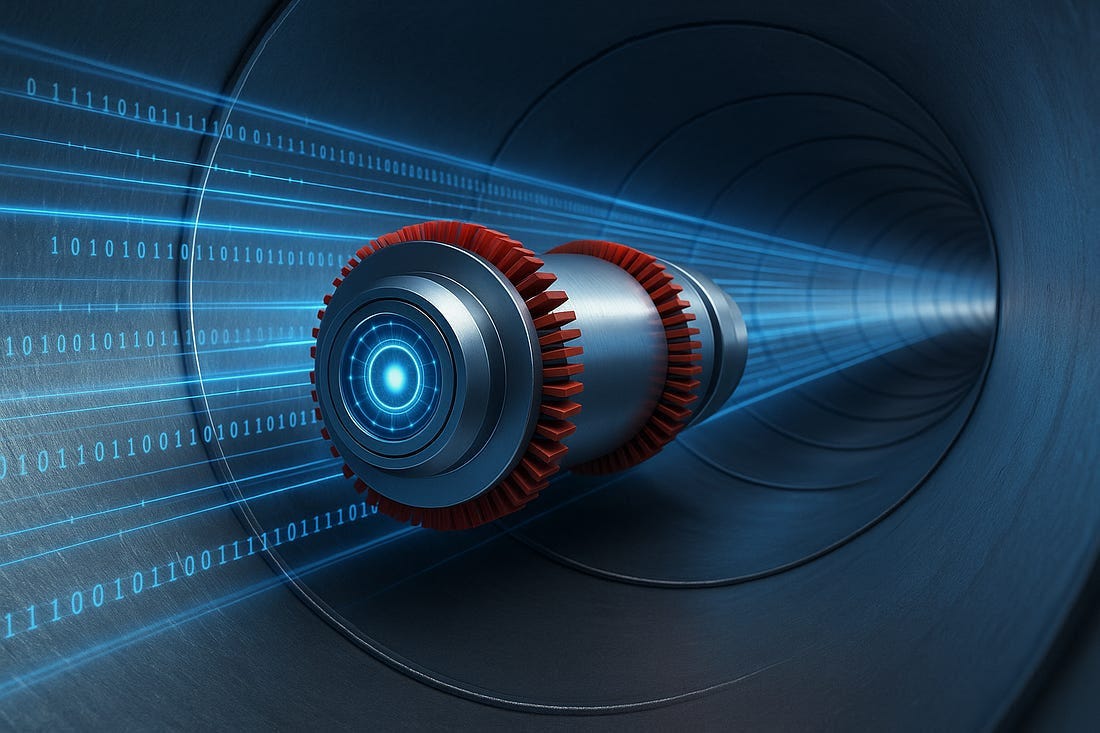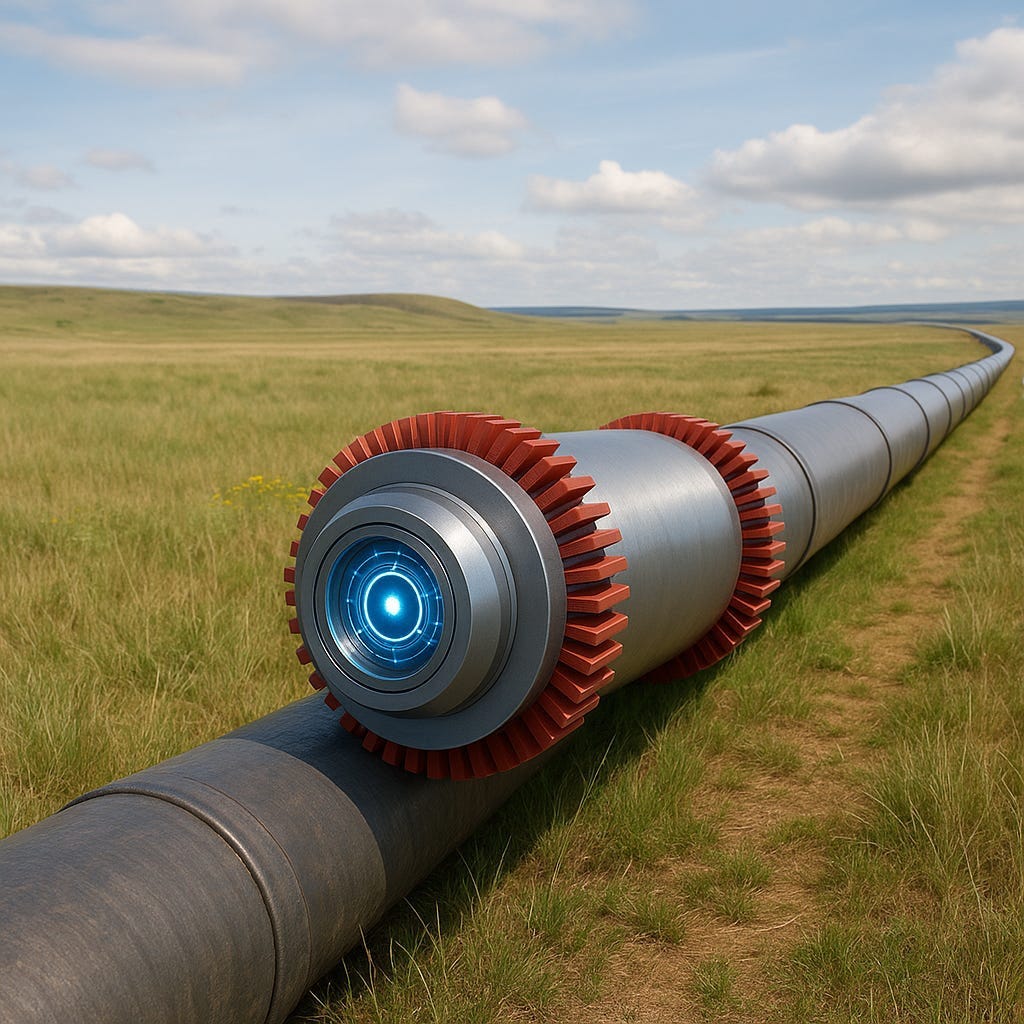HEADLINE: “The Digital Pig: How Smart Pipeline Tech Is Quietly Safeguarding the Backbone of American Energy”, By Jason Spiess
“A new Nature study reveals how advanced pigging systems are redefining pipeline integrity from the inside out, turning maintenance into real-time infrastructure intelligence.”
The Digital Pig: How Smart Pipeline Tech Is Quietly Safeguarding the Backbone of American Energy
A new Nature study reveals how advanced pigging systems are redefining pipeline integrity from the inside out, turning maintenance into real-time infrastructure intelligence.
OCT 9
A recent Scientific Reports article from Nature dives deep into a topic most Americans rarely think about but every oil and gas worker lives by: pigging. These odd-named tools—pipeline inspection gauges, or “pigs”—move through thousands of miles of buried pipe, cleaning, inspecting, and recording the unseen pulse of the energy economy.
The study, “Advances and Challenges in Oil and Gas Pipeline Pigging Technology: A Comprehensive Review,” compiles two decades of global data on how pigging has evolved from a basic maintenance procedure into a highly technical, digital science. The authors call it “a critical node in the intelligent operation of pipeline networks,” emphasizing that modern pigging now generates as much data as it removes debris.
For the U.S. energy sector, where pipelines quietly transport more than 70% of crude oil and refined products, the implications are huge: the health of our infrastructure may soon depend as much on algorithms as on welders.
Traditional pigs were simple devices—foam, rubber, or steel bodies pushed by pressure to scrape out paraffin or rust. Crews would “launch” a pig, track its progress, and hope it emerged at the other end intact. If it didn’t, the operation turned into a scavenger hunt across miles of pipe and prairie.
Modern smart pigs are more like MRI scanners on wheels. They carry arrays of magnetic flux sensors, ultrasound transducers, accelerometers, and GPS locators, all capturing wall thickness, corrosion patterns, and weld integrity in real time. Some units now include AI-assisted interpretation modules that flag abnormalities instantly, not weeks later in a lab report.
In other words, pipeline maintenance is no longer a reactive chore—it’s predictive science.
Data Beneath the Surface
The Nature study’s authors argue that the next frontier in pigging isn’t hardware but data fusion. Every run now generates terabytes of information, which can be cross-referenced with previous inspections, operating pressures, and environmental conditions.
Machine learning algorithms can detect early signs of metal fatigue or micro-cracking long before traditional tests would notice. Some systems even merge pigging data with satellite imagery and drone inspections to create a “digital twin” of the pipeline network—a living model that simulates stresses, corrosion rates, and potential leak points.
It’s a feedback loop between steel and silicon: each pass of a pig makes the system smarter, more efficient, and safer.
Integrity Is Infrastructure
Pipeline integrity isn’t just an engineering term—it’s national resilience. Every rural county that hosts a transmission corridor depends on that infrastructure functioning safely. A single rupture can ripple through communities, economies, and ecosystems.
That’s why the Nature paper’s emphasis on real-time condition assessment matters. When operators can monitor pressure drops and corrosion patterns minute-by-minute, they can prevent incidents before they start. It also reduces costly shutdowns and avoids unnecessary excavation—major wins for both the environment and the bottom line.
Integrity management, once a regulatory checkbox, is becoming a proactive culture.
In an age where energy companies are being scored on their environmental, social, and governance performance, pigging has quietly become part of the ESG toolkit.
Accurate inline inspection data helps operators verify methane-leak reduction claims, document corrosion control for regulators, and schedule maintenance with minimal land disruption. It’s not just about compliance; it’s about credibility.
As the study notes, modern pigging integrates directly with GIS and SCADA systems, meaning emissions data, pressure anomalies, and material stress information can all be logged into a single verifiable platform. For companies navigating carbon-intensity targets, this data chain offers proof of responsible operation—evidence that maintenance and monitoring aren’t afterthoughts but central to sustainability.
Pigs on the Carbon Frontier
The innovations outlined in the Nature study don’t stop with oil and gas. They also map directly onto the next generation of infrastructure: CO₂ and hydrogen pipelines.
Unlike crude or natural gas, these fluids present unique monitoring challenges. CO₂ is supercritical and corrosive when water is present; hydrogen molecules are so small they can embrittle steel. The authors highlight how smart pigs—especially those with acoustic sensors and adaptive sealing—can identify micro-leaks or changes in gas composition at pressures beyond what older systems could handle.
That’s critical for carbon-capture networks expanding across the Midwest and Gulf Coast. A single line failure in a CO₂ trunk system could undermine public trust in the entire decarbonization strategy. Pigging technology may be the quiet assurance these projects need to prove safety and transparency.
Even in this age of digital twins and AI dashboards, the study acknowledges one irreplaceable constant: skilled operators.
Launching a pig still requires experience, intuition, and field judgment. Weather, pressure fluctuations, and unexpected debris can all interfere with runs. The crews who interpret the data are often the same people who have walked those rights-of-way for years.
As one veteran inspector once told The Crude Life, “A smart pig can see what’s wrong. But it still takes a human to understand why.”
That partnership—between machine precision and human perception—is what keeps the pipelines humming.
Industry Outlook: Data as Infrastructure
Pigging technology is no longer just maintenance equipment; it’s an intelligence network woven through the arteries of energy infrastructure.
For oil and gas, it means fewer surprises and more uptime. For regulators, it means verifiable safety metrics. For communities along the right-of-way, it means confidence that the infrastructure beneath their fields and rivers is being watched over constantly.
As the Nature authors conclude, “Integration of intelligent pigging with digital management systems will be key to achieving sustainable and reliable pipeline operation.” In plain terms: the data is now as valuable as the pipe itself.
In an era when new pipelines face political, regulatory, and financial scrutiny, maintaining the ones we have—smarter, cleaner, and safer—might just be the most practical act of energy innovation. The digital pig doesn’t roar or drill or flare; it hums quietly underground, carrying the future of infrastructure integrity on its back.
Jason Spiess is an multi-award-winning journalist, entrepreneur, producer and content consultant. Spiess, who began working in the media at age 10, has over 35 years of media experience in broadcasting, journalism, reporting and principal ownership in media companies. Spiess is currently the host of several newsmagazine programs that air across a 22 radio stations and podcasts worldwide through podcast platforms, as well as a combined Substack and social media audience of over 500K followers. Connect with Spiess on LinkedIn
BOTTOMLINE: “In an era when new pipelines face political, regulatory, and financial scrutiny, maintaining the ones we have—smarter, cleaner, and safer—might just be the most practical act of energy innovation. The digital pig doesn’t roar or drill or flare; it hums quietly underground, carrying the future of infrastructure integrity on its back.”









